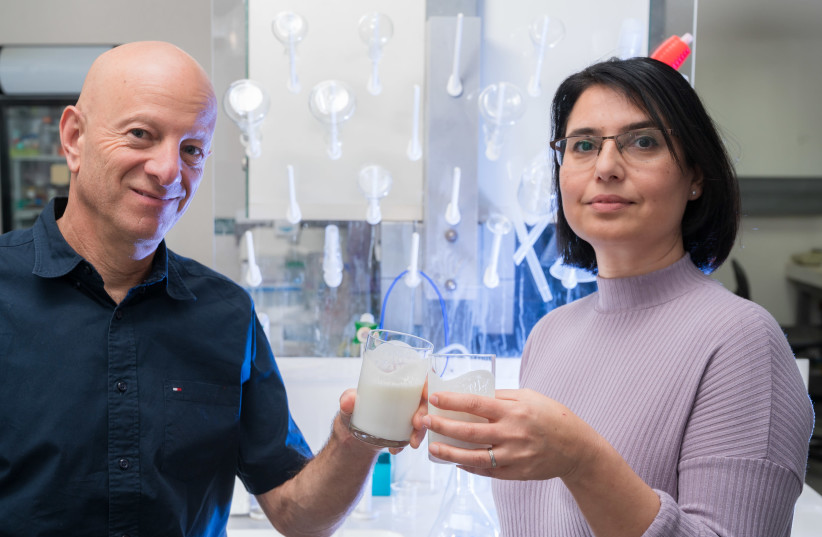Can a cup of probiotic yogurt help save the lives of people with COVID-19? Researchers at Ben-Gurion University of the Negev say they have identified molecules in kefir yogurt that are effective in treating various inflammatory conditions, including “cytokine storms” caused by COVID-19. Kefir is a fermented beverage made by inoculating cow’s or goat’s milk. with microorganism mixtures, such as yeast and bacteria. A cytokine storm is when the body’s immune system goes in an excessive direction and attacks itself – one of the leading causes of death in COVID-19 patients. The research was done by Ph.D. student Orit Malka and prof. Raz Jelinek, vice-president and dean for research and development at the BGU. It was recently published in the peer-reviewed journal Microbiome, Jelinek said The Jerusalem Post that Malka noticed several years before the coronavirus pandemic that yogurt had a therapeutic effect, and began studying it in Jelinek’s laboratory. Together, they identified molecules in the yogurt that had dramatic antibacterial and anti-inflammatory properties. “One of the main reasons why people die from COVID is the cytokine storm,” Jelinek explained. Cytokines are immune molecules designed to help the body fight off invaders such as viruses. But in certain circumstances – and scientists do not know exactly why – the body goes into a kind of exaggeration and secretes many cytokines, so much so that it kills you. This is what happens during COVID. “We knew we had found these molecules in yogurt with anti-inflammatory properties,” Jelinek continued. “When COVID started, we said, let’s see if these molecules can help with cytokine storms.”
cnxps.cmd.push (function () {cnxps ({playerId: ’36af7c51-0caf-4741-9824-2c941fc6c17b’}). deliver (‘4c4d856e0e6f4e3d808bbc1715e132f6’);});
if (window.location.pathname.indexOf (“656089”)! = -1) {console.log (“hedva connatix”); document.getElementsByClassName (“divConnatix”)[0].style.display = “none”;}Jelinek and Malka caused cytokine storms in mice. Then they looked at what had happened. The mice that had the storm and that were not treated are dead. But the mice treated with the molecules they found in the yogurt recovered completely. The molecules not only eliminated the cytokine storm but also restored the balance in the immune system. “It was really remarkable,” Jelinek said. The scientists said that they also administered the molecules to the mice via their mouths – they were placed in the water and, like a normal drink, penetrated the mice’s digestive system. During the pandemic, Jelinek and Malka hoped that they would be able to administer these molecules to patients who were in a critical condition, but Jelinek said that the regulatory barriers were slowing down the process, and that they were not succeeding. The next step is to perform clinical trials with other cytokine storms. “Cytokine storms do not just happen with COVID,” Jelinek said. “It is a very bad condition with very few treatments for it.” The researchers are at the end of setting up a business under the BGN Technologies umbrella for further development and commercialization of the technology. Jelinek said the company should formally launch within the next few weeks, and then they will raise funds to conduct clinical trials. His hope is that trials will be able to start within a few months, but the road from the laboratory to the table will probably be long, although these molecules come from yogurt that people can eat every day. Jelinek said they would be considered a drug and therefore the new medicine should be fully investigated before it is approved. As such, he said that they would probably take the molecules in a different direction at the same time – as food additives, probiotics or supplements, which would speed up the approval process. Jelinek noted that he and Malka had other experiments with the Kefir and that they could also show that the molecules have the potential to fight pathogenic bacteria. Specifically, they showed that the molecules could significantly reduce the virulence of the causative agent of cholera. “This is the first demonstration that virulence of human pathogenic bacteria can be mitigated by molecules secreted in probiotic dairy products, such as yogurt or kefir,” Jelinek said. ‘I do not think there were any molecular mechanisms that people probably knew had a therapeutic effect. Now we know. ‘
